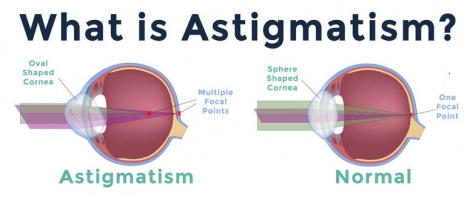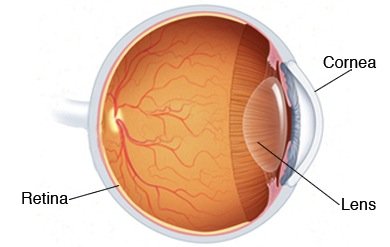Astigmatism

Astigmatism is a common and generally treatable imperfection in the curvature of your eye that causes blurred distance and near vision.
Astigmatism occurs when either the front surface of your eye (cornea) or the lens, inside your eye, has mismatched curves. Instead of having one curve like a round ball, the surface is rugby ball shaped. This causes blurred vision at all distances.
Astigmatism is often present at birth and may occur in combination with short sightedness or long sightedness.

Symptoms
Signs and symptoms of astigmatism may include:
- Blurred or distorted vision
- Eyestrain or discomfort
- Headaches
- Difficulty with night vision
- Squinting
Children and adolescents
Children may not realize their vision is blurry, so they need to be screened for eye disease and have their vision tested by a qualified professional on an annual basis.
Causes
Simplified anatomy of the eye
Your eye has two structures with curved surfaces that bend (refract) light onto the retina, which makes the images:
- The cornea, the clear front surface of your eye along with the tear film
- The lens, a clear structure inside your eye that changes shape to help focus on near objects
In a perfectly shaped eye, each of these elements has a round curvature, like the surface of a smooth ball. A cornea and lens with such curvature bend (refract) all incoming light to make a sharply focused image directly on the retina, at the back of your eye.

A refractive error
If either your cornea or lens is egg shaped with two mismatched curves, light rays aren't bent properly, causing a refractive error. This makes a blurry image. Astigmatism is a type of refractive error.
Astigmatism occurs when your cornea or lens is curved more steeply in one direction than in another. You have corneal astigmatism if your cornea has mismatched curves. You have lenticular astigmatism if your lens has mismatched curves.
Either type of astigmatism can cause blurred vision.
Astigmatism may be present from birth, or it may develop with age.
When to see a doctor
You will require an eye examination if your eye symptoms detract from your enjoyment of activities or interfere with your ability to perform everyday tasks. An eye examination can determine whether you have astigmatism and, if so, to what degree.
If you have any concerns about your own or your child’s eyes or suspect they may have astigmatism – Please don’t hesitate to contact the clinic on 021 4341030 or bgolchin@corkeyeclinic.ie






